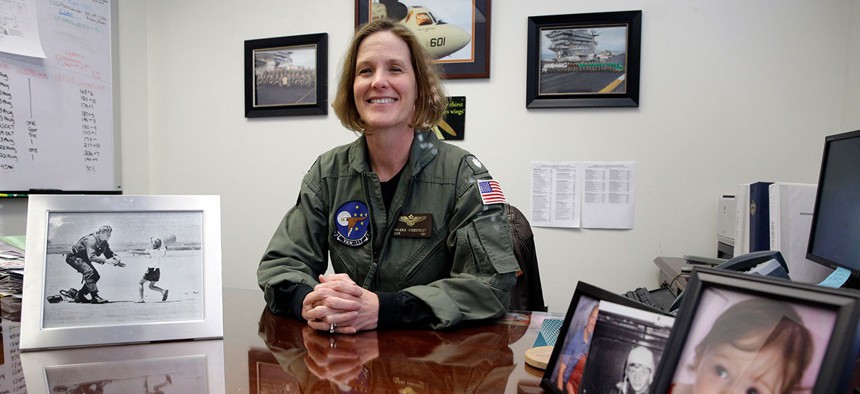
Valerie Overstreet took a sabbatical from the Navy. Patrick Semansky/AP
Burned Out? Take a Sabbatical
In 2009, the U.S. Navy started offering a career break to help retain service members. Now the other armed forces—and private companies—are following suit.
According to a recent report called Calculating the True Cost of Voluntary Turnover, the average turnover rate across the workforce is 13 percent. If an organization has 30,000 employees and that rate of turnover is assumed, the report authors estimate the cost to the organization would be a staggering $427 million per year.
We know that turnover is expensive and that job tenure is low, with a median employment length of less than five years. What’s surprising is that most employers haven’t done anything to address retention, except to keep recruiting and replacing.
The U.S. Navy is different. Several years ago, its leaders sought to understand why people were quitting, and learned that it wasn’t because they didn’t like the Navy. Rather, it was because a lifelong naval career required sacrifices that some employees weren’t willing to make.
The Navy’s leadership realized a simple fact: If you have a known entity—someone who is a strong, trusted contributor—you want to keep them. And you can do that by giving them choices.
In 2009, the service established the Career Intermission Program to address its sailors’ work/life challenges. Since then, every year, it has allowed up to 20 officers and 20 enlisted sailors to take a sabbatical from their military service, transitioning into the reserves for up to three years.
During their intermission, sailors retain full medical and dental benefits for themselves and their dependents, commissary and Navy Exchange benefits, and a monthly stipend equal to a small fraction of active-duty basic pay. They also get a one-time change of station.
Upon returning to active duty, they can compete in promotion boards with service members at the same experience level. In other words, people who take advantage of this option don’t face a career penalty because of it.
Ken Hockycko, a Navy lieutenant commander, flew F/A-18 airplanes for a living, as did his wife. In four years of marriage, the pair had gone on five deployments to bases around the world. “We loved the Navy and we loved our jobs, but the situation was incompatible with our other priorities to develop professionally and start a family,” says Hockycko. “I thought I’d have to resign.”
The Navy didn’t want him to go and suggested he enroll in the CIP. Hockycko pursued a MBA at Dartmouth Business School. When he returned to the military after two years, as a new father, Hockycko immediately started the next tour in his progression. “The Navy recognized that gaining a broader perspective, and diversifying my experiences outside the cockpit, would make me a more effective leader for our country,” he says.
Post-CIP, Hockycko became a speechwriter for the Secretary of the Navy and then moved into his current role representing the Navy on Capitol Hill as a defense liaison. Someday, he hopes to be a squadron’s commanding officer. “CIP creates a mechanism for people to continue to serve while exploring things that are important to them and ultimately benefit the organization,” he says.
Valerie Overstreet, a Navy captain, applied for CIP because she and her husband—who is also in the Navy—were on different rotation schedules and could never manage to live in the same place. She had a daughter and worked toward a master’s degree in education at the University of Maryland during her CIP stint. When she returned to active duty, Overstreet was able to synchronize her orders with those of her husband. The Navy is now able to co-locate the pair, and Overstreet has been promoted.
Career Intermission has been extended through the end of 2019 and will be expanded. The number of participants had been capped by law at 40, but that’s no longer the case. Still, uptake has been slow: Not all spots have been claimed, possibly due to the small stipend or the requirement of additional service (an extra two months for every one month of intermission).
“Based on sailor feedback, the Navy applied for and was granted improvements from Congress, including an increase in the number of participants,” says Nate Christensen, a Navy spokesperson. The Air Force, Army, and Marine Corps have all followed the Navy’s lead and launched their own pilot programs.
If sanctioned career breaks work, why don’t more employers offer them? A few large companies, including Boston Consulting Group and Intel, have offered sabbaticals for years, and other employers are now starting to, although these sabbaticals tend to be shorter than the Navy’s—more like extended vacations. Some include full pay, however.
Whatever the break is called and however long it’s for, it’s likely to benefit the health of those who take it up. Fifty-five percent of Americans don’t use all their paid vacation days, and even more of them work while they’re on vacation. Occupational stress can lead to anxiety or depression and is associated with chronic diseases such as diabetes. A 2010 study found that sabbatical leaves of six months or more reduced individuals’ stress levels. Even short vacations can improve people’s well-being, as long as the vacations are not poorly planned (and therefore stressful).
“It’s the best thing that could have happened to my husband and me, because neither of us had to give up our careers,” Overstreet says of her intermission. “And CIP hasn’t hurt my progress at all. On paper, it doesn’t even look like I took time off.”






